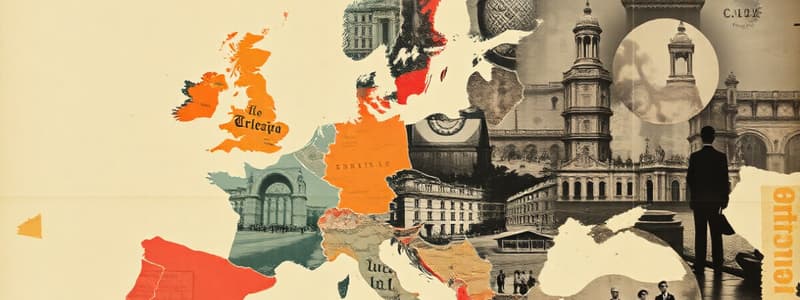Podcast
Questions and Answers
Koja od sljedećih zemalja nema jedan od službenih jezika koji se koristi u Švicarskoj?
Koja od sljedećih zemalja nema jedan od službenih jezika koji se koristi u Švicarskoj?
- Francuska
- Rumunjska (correct)
- Italija
- Njemačka
Koje razdoblje označava nastanak Europske ekonomske zajednice?
Koje razdoblje označava nastanak Europske ekonomske zajednice?
- 1957. (correct)
- 1989.
- 1870-ih
- 1965.
Koje od sljedećih jezika spada među glavne skupine indoeuropskih jezika?
Koje od sljedećih jezika spada među glavne skupine indoeuropskih jezika?
- Baskijski
- Slavenski (correct)
- Mađarski
- Kineski
Koja od sljedećih afirmacija o iseljivačkim valovima nije točna?
Koja od sljedećih afirmacija o iseljivačkim valovima nije točna?
Koji je vodeći razlog za demografsku tranziciju?
Koji je vodeći razlog za demografsku tranziciju?
Koja organizacija nije povezana s vojnopolitičkim savezima?
Koja organizacija nije povezana s vojnopolitičkim savezima?
Koji je glavni cilj populacijske politike?
Koji je glavni cilj populacijske politike?
Koja od sljedećih informacija o gustoći naseljenosti je točna?
Koja od sljedećih informacija o gustoći naseljenosti je točna?
Flashcards
Demografska tranzicija
Demografska tranzicija
Prijelaz društva s visoke smrtnosti i rodnosti na nisku smrtnost i rodnost.
Monarhija
Monarhija
Oblik vladavine kojim vlada kralj ili kraljica.
Najgušće naseljena regija u Europi
Najgušće naseljena regija u Europi
Zapadna Europa.
Nastanak EU-a
Nastanak EU-a
Signup and view all the flashcards
Europska ekonomska zajednica
Europska ekonomska zajednica
Signup and view all the flashcards
Populacijska politika
Populacijska politika
Signup and view all the flashcards
Glavne skupine indoeuropskih jezika
Glavne skupine indoeuropskih jezika
Signup and view all the flashcards
Iseljavački valovi
Iseljavački valovi
Signup and view all the flashcards
Study Notes
Population and Demographics
- 741 million inhabitants
- Population density: 74 people per square kilometer
- Age structure: More elderly than young, more males
- Monarchies: Some countries have Kings or Queens as head of state.
- Demographic Transition: Shift from high death/birth rates to low rates.
Languages
- Major Indo-European language families: Slavic, Germanic, Uralic, Romance, Turkic, others.
- Official languages of Belgium: Dutch, French, German.
- Official languages of Switzerland: Romansh, French, German, Italian.
Religion
- Major religious groups: Orthodox, Catholic, Protestant, Islam.
- This reflects regional and historical divisions.
Migration
- Four waves of migration
- 1st wave: Exploration and colonization
- 2nd wave: Industrialization and urbanization
- 3rd wave: Post-WWI/WWII conflicts
- 4th wave: Recent economic and political pressures
- These are tied to specific historical periods.
Geographical Discoveries
- European countries started to explore regions as a result of geographic discoveries.
Political Structure
- EU formation started around 1950s.
- Major EU institutions include the European Parliament (Strasbourg), European Commission (Brussels), Council of the EU (Brussels), and the European Council (Brussels).
- Important EU city: Luxembourg
Economic Organizations
- World's largest economy and market
- EU, NATO, Council of Europe, Schengen Agreement, EFTA, OECD, CEFTA.
- These organizations aim to increase cooperation and trade in Europe.
Studying That Suits You
Use AI to generate personalized quizzes and flashcards to suit your learning preferences.




